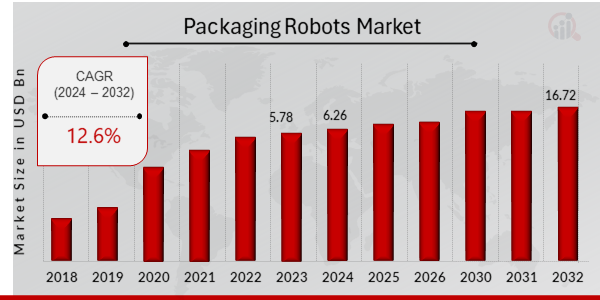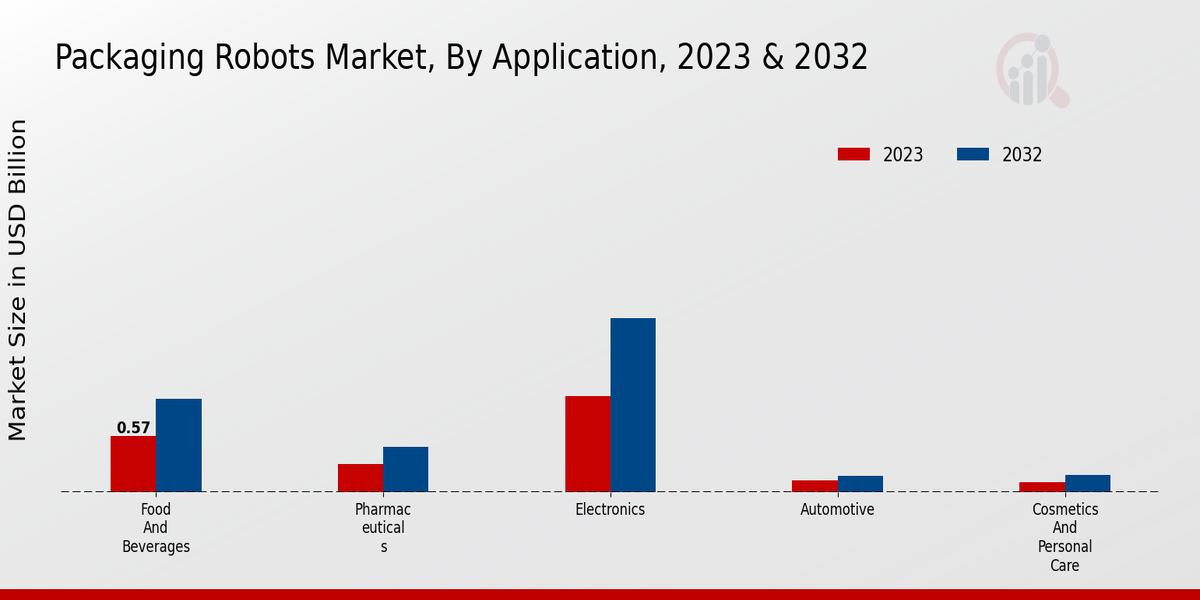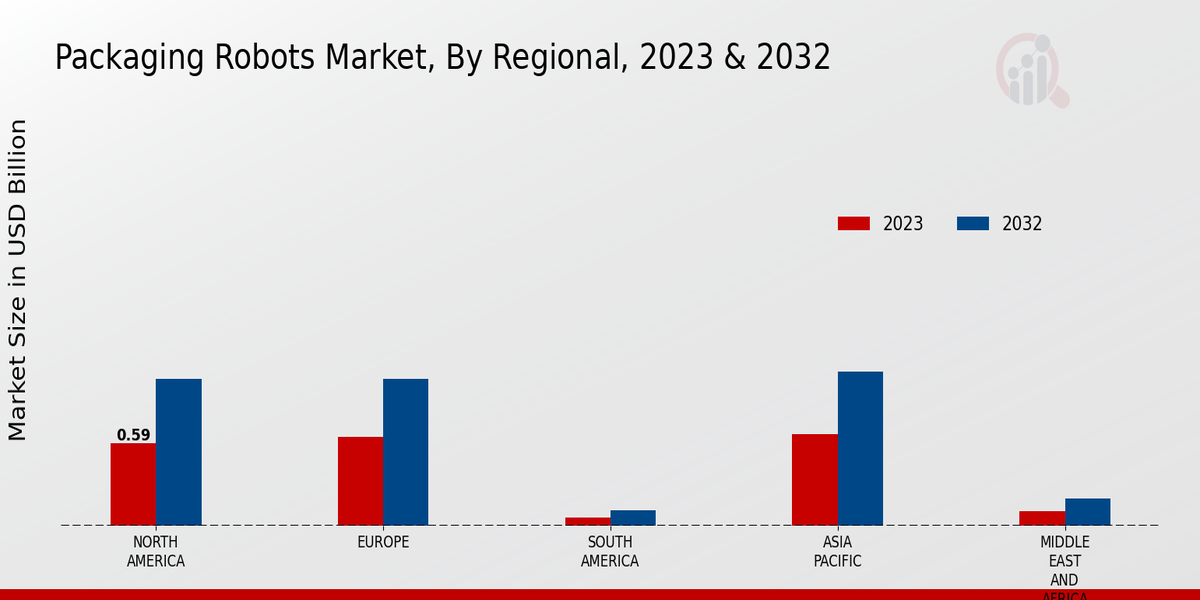Global Packaging Robots Market Overview:
Packaging Robots Market Size was estimated at 5.78 (USD Billion) in 2023. The Packaging Robots Industry is expected to grow from 6.26 (USD Billion) in 2024 to 16.72 (USD Billion) by 2032. The Packaging Robots Market CAGR (growth rate) is expected to be around 12.6% during the forecast period (2024 - 2032)
Key Packaging Robots Market Trends Highlighted

Source: Primary Research, Secondary Research, MRFR Database and Analyst Review
Packaging Robots Market Drivers
Rising Demand for Automation in Packaging Processes
There are many drivers of the Packaging Robots Market Industry, and one of the major drivers is the increasing adoption of automation in various industries, such as food and beverage, pharmaceuticals, and consumer goods. Packaging robots offer several advantages over manual labor, and the most significant one is that these robots are incredibly efficient, accurate, and productive. The Packaging Robots Market Industry is experiencing significant growth because of the increasing popularity of these robots. In addition, packaging robots can perform repetitive tasks consistently and quickly without any breaks, which makes them a suitable option for manufacturers who wish to minimize costs and streamline their packaging operations. Furthermore, there is a growing demand for automated packaging solutions, which is expected to drive the growth of the Packaging Robots Market Industry in the next few years.
Advancements in Robotics Technology
The Packaging Robots Market Industry is a growing sector with the advancement of robotics technology. Emerging technologies such as artificial intelligence and machine learning have enabled the development of more advanced packaging robots. Packaging robots are now used for a variety of packaging tasks, including complex and delicate tasks. The use of AI and ML is also giving rise to smarter and more adaptive robots that can understand and adapt to the changing packaging requirements of manufacturers.
Growing Emphasis on Product Quality and Safety
The Factor driving the Packaging Robots Market Industry is Growing emphasis on product quality and safety. Packaging helps products to preserve and protect them from damage and contamination. Additionally, using robotics for packaging ensures that products are handled with precision and care. Further, packaging robots can also be combined with the quality control system to ensure that only the products meeting the required standards are packed and shipped. This helps maintain a high product quality and safety standards and build brand value.
Packaging Robots Market Segment Insights:
Packaging Robots Market Application Insights
The Packaging Robots Market is classified by Application as Food and Beverages, Pharmaceuticals, Electronics, Automotive, Cosmetics and Personal Care, and Others. The Food and Beverages segment observed being the largest segment of the Packaging Robots Market in 2023 and is anticipated to dominate the market by 2032 as well. The increase in market growth of this segment can be attributed to the rising apprehension of packaged food and beverages among consumers. Over and above, the exigency for automation in the food and beverage industry has boosted the growth of this segment. Following, is the Pharmaceuticals segment, which is the second largest segment of the Packaging Robots Market and is expected to grow at a CAGR of substantial proportion in the forecasted period.
The upgrowth of this segment is due to the rise in the demand for automated packaging solutions in the pharmaceutical industry coupled with the increasing pressure regarding organizations to comply with regulatory requirements. Moreover, the third largest segment of the Packaging Robots Market is the Electronics segment, which is expected to witness an upsurge at a sluggish pace in the forecasted period. The incline in the growth of this segment can be attributed to the demand for automated packaging solutions coupled with the prerequisite to protect the fragile electronic components. To follow is the Automotive segment, which being the fourth largest segment is anticipated to occupy a moderate pace of growth. The extension of this segment can be associated with the increase in the demand for automated packaging solutions in the automotive industry separated with the necessity of protecting the automotive parts.
Subsequently, the Cosmetics and Personal Care segment is the fifth largest segment in the Packaging Robots Market which is anticipated to acquire a steady pace of growth. The progress of this segment can be linked to the rise in the demand for the automated packaging solutions in Cosmetics and Personal Care industry, coupled with the prerequisite of protecting the fragile Cosmetics and Personal Care products. The segment, Others classify applications such as chemicals, metals, and plastics, and is anticipated to grow at a CAGR of significant proportion. The demand for automated packaging solutions in the respective industries has fuelled the growth of this segment.

Source: Primary Research, Secondary Research, MRFR Database and Analyst Review
Packaging Robots Market Type Insights
The Packaging Robots Market segmentation by Type includes Articulated Robots, Cartesian Robots, SCARA Robots, Delta Robots, Collaborative Robots, and Others. Among these, the Articulated Robots segment accounted for the largest market share in 2023 and is expected to continue its dominance during the forecast period. The market growth can be attributed to their flexibility, reach, and ability to handle complex packaging tasks. Cartesian Robots are projected to witness a steady growth rate due to their accuracy and repeatability, making them suitable for precise packaging applications. SCARA Robots, with their fast cycle times and compact design, are anticipated to gain significant traction in the coming years. Delta Robots offer high speed and precision, which makes them ideal for high-volume packaging lines. Collaborative Robots, designed to work alongside human operators, are expected to contribute to the market's growth as they enhance safety and efficiency. The Others segment, which includes specialized robots for unique packaging applications, is also anticipated to experience growth.
Packaging Robots Market Payload Capacity Insights
The payload capacity segment plays a crucial role in the Packaging Robots Market. In 2023, the "Below 10 kg" segment held the largest revenue share of 37%, driven by its versatility and affordability for various packaging applications. The "10-50 kg" segment is projected to witness significant growth by 2032, owing to its increased adoption in heavy-duty packaging operations. The "50-150 kg" and "150-500 kg" segments are expected to grow steadily, catering to specific industries such as automotive and food beverage. The "Above 500 kg" segment, though accounting for a smaller share, presents opportunities for customized solutions in industries like aerospace and construction. The segmentation of the Packaging Robots Market based on payload capacity provides insights into the diverse needs of end-users across various industries, enabling tailored solutions and driving market growth.
Packaging Robots Market Functionality Insights
The Functionality segment of the Packaging Robots Market is expected to grow significantly in the coming years. In 2023, the segment was valued at USD 1,745.4 million and is projected to reach USD 2,784.0 million by 2032, exhibiting a CAGR of 6.2% during the forecast period. This growth can be attributed to the increasing demand for automation in the packaging industry, which has led to the adoption of robots for various tasks such as picking and placing, palletizing and depalletizing, case packing and unpacking, labeling and marking, inspection and quality control, and others. Among these, the picking and placing functionality held the largest market share in 2023, accounting for over 35% of the Packaging Robots Market revenue. This is due to the increasing use of robots for automated product handling and assembly in various industries such as food and beverage, pharmaceuticals, and consumer goods. The palletizing and depalletizing functionality is also expected to witness significant growth during the forecast period, owing to the rising demand for automated pallet handling solutions in warehouses and distribution centers. Additionally, the growing adoption of robots for labeling and marking applications is expected to drive the growth of this functionality segment in the coming years.
Packaging Robots Market Regional Insights
The Packaging Robots Market is segmented into North America, Europe, APAC, South America, and MEA. Among these regions, North America held the largest market share in 2023 and is expected to continue its dominance throughout the forecast period. The growth in this region can be attributed to the increasing adoption of automation in the packaging industry to enhance efficiency and productivity. Europe is another significant market for packaging robots, driven by stringent regulations regarding product safety and quality. The APAC region is anticipated to witness substantial growth in the Packaging Robots Market during the forecast period. The rising demand for packaged goods and the presence of a large manufacturing base in countries like China and India contribute to the growth in this region. South America and MEA are also expected to experience steady growth in the market due to increasing investments in the food and beverage industry.

Source: Primary Research, Secondary Research, MRFR Database and Analyst Review
Packaging Robots Market Key Players and Competitive Insights:
Major players in the Packaging Robots Market industry are focusing on developing innovative and advanced packaging solutions to meet the growing demand for efficient and automated packaging processes. Leading Packaging Robots Market players are investing in research and development to enhance the capabilities of their robots, such as increasing speed, accuracy, and flexibility. The Packaging Robots Market development is also driven by the adoption of artificial intelligence (AI) and machine learning (ML) technologies, which enable robots to perform complex tasks and adapt to changing production environments.
The competitive landscape is characterized by a mix of established players and emerging startups, each with its unique strengths and offerings. One of the leading companies in the Packaging Robots Market is ABB. The company offers a wide range of packaging robots, including palletizing robots, case packing robots, and robotic cells. ABB's robots are known for their reliability, precision, and speed. The company has a strong global presence and serves a diverse customer base in various industries, including food and beverage, pharmaceuticals, and consumer goods. ABB is committed to innovation and continuously invests in research and development to enhance its product offerings and meet the evolving needs of its customers. A notable competitor in the Packaging Robots Market is FANUC.
The company provides a comprehensive portfolio of packaging robots, including articulated robots, SCARA robots, and collaborative robots. FANUC's robots are designed for high-speed and high-precision applications. The company has a strong focus on automation and offers a range of software and services to support the integration of its robots into production lines. FANUC has a global presence and serves customers in various industries, including automotive, electronics, and food and beverage. The company is known for its commitment to quality and customer satisfaction.
Key Companies in the Packaging Robots Market Include:
-
Kawasaki
-
ABB
-
Epson
-
Universal Robots
-
Rockwell Automation
-
YASKAWA
-
Denso
-
Mitsubishi Electric
-
Omron
-
Staubli
-
KUKA
-
Comau
-
FANUC
Packaging Robots Industry Developments
The Packaging Robots Market is expected to reach USD 3.5 billion by 2032, exhibiting a CAGR of 6.21% during the forecast period (2024-2032). The rising demand for automation in the packaging industry, coupled with the increasing adoption of robotics for improved efficiency and productivity, is driving the market growth. Recent developments in the market include the integration of AI and machine learning technologies into packaging robots, enabling them to handle complex packaging tasks with greater precision and speed. Additionally, the growing popularity of e-commerce and the need for faster and more efficient order fulfillment are creating significant opportunities for the adoption of packaging robots.
Packaging Robots Market Segmentation Insights
Packaging Robots Market Application Outlook
Packaging Robots Market Type Outlook
-
Articulated Robots
-
Cartesian Robots
-
SCARA Robots
-
Delta Robots
-
Collaborative Robots
-
Others
Packaging Robots Market Payload Capacity Outlook
-
Below 10 kg
-
10-50 kg
-
50-150 kg
-
150-500 kg
-
Above 500 kg
Packaging Robots Market Functionality Outlook
-
Picking and Placing
-
Palletizing and Depalletizing
-
Case Packing and Unpacking
-
Labeling and Marking
-
Inspection and Quality Control
-
Others
Packaging Robots Market Regional Outlook
-
North America
-
Europe
-
South America
-
Asia Pacific
-
Middle East and Africa
| Report Attribute/Metric |
Details |
| Market Size 2023 |
5.78 (USD Billion) |
| Market Size 2024 |
6.26 (USD Billion) |
| Market Size 2032 |
16.72 (USD Billion) |
| Compound Annual Growth Rate (CAGR) |
12.6% (2024 - 2032) |
| Report Coverage |
Revenue Forecast, Competitive Landscape, Growth Factors, and Trends |
| Base Year |
2023 |
| Market Forecast Period |
2024 - 2032 |
| Historical Data |
2019 - 2023 |
| Market Forecast Units |
USD Billion |
| Key Companies Profiled |
Kawasaki, ABB, Epson, Universal Robots, Rockwell Automation, YASKAWA, Denso, Mitsubishi Electric, Omron, Staubli, KUKA, Comau, FANUC |
| Segments Covered |
Application, Type, Payload Capacity, Functionality, Regional |
| Key Market Opportunities |
Growing ecommerce adoptionIncreased demand for automationAdvancements in robot technologySustainability initiativesLabor shortages |
| Key Market Dynamics |
Rising automation Ecommerce boom Labor shortage Technological advancements Growing demand for flexible packaging |
| Countries Covered |
North America, Europe, APAC, South America, MEA |
Frequently Asked Questions (FAQ) :
The Packaging Robots Market was valued at approximately USD 6.26 billion in 2024 and is projected to reach USD 16.72 billion by 2032, exhibiting a CAGR of 12.6% over the forecast period.
North America region currently dominates the Packaging Robots Market and is expected to maintain its dominance throughout the forecast period. China, Japan, and South Korea are the major contributors to the market growth in this region.
The increasing demand for automation in the packaging industry, the rising need for efficient and flexible packaging solutions, and the growing adoption of robotics in various end-use industries are the primary growth drivers of the Packaging Robots Market.
The food and beverage, pharmaceutical, and consumer goods industries are the major application segments of the Packaging Robots Market. These industries require high levels of automation and efficiency in their packaging processes, which is driving the demand for packaging robots.
ABB, Fanuc, KUKA, Yaskawa, and Kawasaki are some of the prominent players in the Packaging Robots Market. These companies offer a wide range of packaging robots that cater to the diverse needs of various industries.
The high cost of packaging robots, the lack of skilled professionals to operate and maintain them, and the stringent regulatory requirements are some of the challenges faced by the Packaging Robots Market.
The adoption of collaborative robots, the integration of artificial intelligence and machine learning, and the development of robots with advanced capabilities are some of the latest trends in the Packaging Robots Market.
The Packaging Robots Market is expected to grow at a CAGR of 12.6% from 2024 to 2032.
The increasing demand for automation in the packaging industry, the rising need for efficient and flexible packaging solutions, and the growing adoption of robotics in various end-use industries are the primary factors driving the growth of the Packaging Robots Market.
The Packaging Robots Market is segmented based on type, application, and region. By type, the market is divided into articulated robots, cartesian robots, and SCARA robots. By application, the market is segmented into food and beverage, pharmaceutical, consumer goods, and other industries.

















